The Only Table Saw Buying Guide You Need
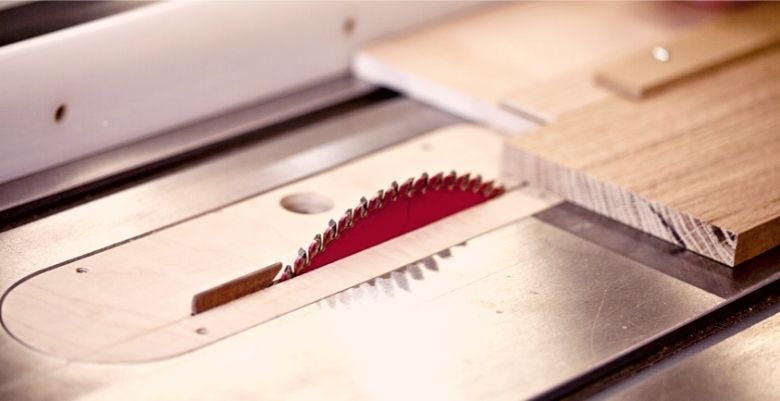
Here you will learn everything you need to know about table saws and how to buy one.
Regardless of the woodworking project, there is a good chance that you will need one of the most versatile power tools in any workshop: the table saw. But not all table saws are created equally nor is every table saw right for the same job. The question is: what table saw should you buy?
This table saw buying guide provides useful advice to help you navigate the market and find the right model for any job.
Table of Contents
Which Table Saw Should You Buy?
This article reviews the best models from brands like Skil, DeWALT, Bosch, and more. Which one takes the #1 spot? Read the article to find out.
What Table Saw Should You Buy?
In short, there are essentially five main types of table saws you can choose from. Below is a brief explanation of each type:
- Bench Top – this is the smallest type of table saw. It sacrifices a bit in terms of power, but can be set up virtually anywhere. Benchtop models tend to be inexpensive which is perfect for the DIYer.
- Jobsite – able to generate significantly more cutting power than benchtop models. Jobsite table saw almost always comes equipped with a handy rolling stand to make transporting it easier.
- Contractor – once an incredibly popular type due to their power, lower price and better mobility. This type is being pushed into obsolescence due to “lower class” table saws being able to deliver better performance and higher portability.
- Cabinet – This is the “big daddy” of table saws with both their performance and their price proudly displaying that fact. Cabinet table saws are the go-to choice for professional woodworkers.
- Hybrid – hybrids are close to cabinet table saws. Hybrid occupy less space while packing similar cutting power. Hybrids are often less expensive than cabinet saws, .
Ask These Questions First
What Kind Of Work Do You Intend To Do?
This is arguably the most important question to ask before looking at table saws. It all comes down to whether you are a professional contractor, a master woodworker, or just a weekend DIYer.
- If you are a professional contractor, a jobsite table saw with rolling stand is your best choice (think DEWALT DWE7491RS or SKILSAW SPT99-11).
- For casual DIYers, a smaller-sized portable option is best (DEWALT DWE7485 or SKIL TS6307-00 come to mind here).
- Professional woodworkers should opt for a cabinet or a hybrid table saw.
How Much Space Do You Have In Your Workshop?
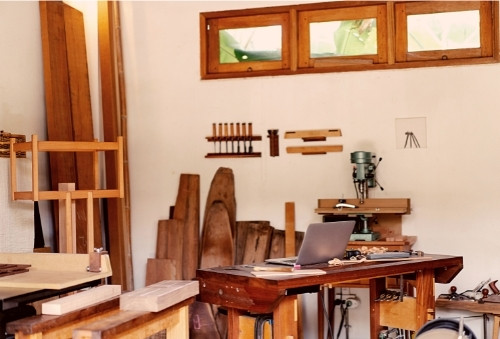
While this is an important question, it is worth noting that it can often wrap back into the prior question depending on the kind of work the table saw is needed for. For instance, professional contractors often need to take their table saw with them onto job sites which will not only impact portability but other aspects as well.
Of course, even if the table saw remains stationary in a workshop, the amount of space you have will be a major influencing factor. The difference in size between a benchtop table saw and a cabinet model is immense with the former often being storable when finished and the latter being immovable and taking upwards of 20 sq ft.
What Is Your Budget?
This question sits at the bottom for good reason as it is not the aspect that should determine the baseline when choosing a table saw– though it often determines the ceiling. Ultimately, choosing a cheaper table saw will show itself in the results, and making sure the table saw can accomplish its stated goal is paramount.
Of course, there are plenty of extra features which can drive up the price of a table saw beyond its pure effectiveness. In this instance, it can be okay to compare prices with extra features like table saw accessories and extensions. However, safety features and build quality should not be ignored in favor of a lower price tag.
Best Budget Options
On a shoestring budget? Check out this review to find out which inexpensive table saw is worth buying.
What To Look For In A Table Saw
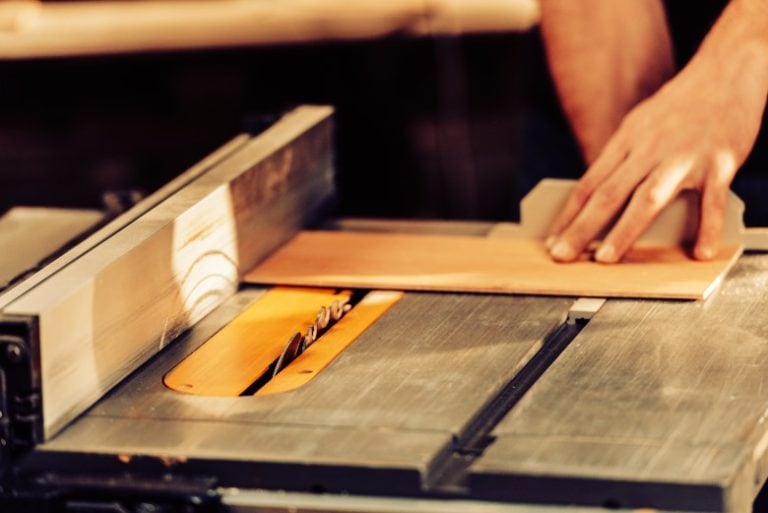
Overall Build Quality
While this quality will not help you determine the table saw based on the type of job it is needed for, it will ultimately play a huge role in its overall value. This is especially important when considering that a solid table saw can cost anywhere from high three figures to a couple of thousands of dollars depending on its type.
The main quality to look at when comparing a table saw’s overall build quality are the materials as they impact both durability and performance. From a performance perspective, the materials reduce vibration which can lead to imprecise cuts. The main materials used for table saws are plastic, aluminum, stainless steel, and cast iron.
Of the group, cast-iron provides the best vibration reduction but is excessively heavy and more expensive. Plastic, while the least expensive, is also obviously the least durable and vibrates more than the other materials. Stainless steel and aluminum are both solid with stainless steel reducing vibration better but aluminum being lighter and more portable.
Power
This quality often gets the most advertising space and is important, but it is not nearly as important as brands and inexperienced DIYers would have you believe. Of the various qualities, horsepower and amps tend to be the most important in terms of cutting power as they directly impact torque.
How much power do you need?
- For hobbyist DIY projects: a table saw with a 2-HP motor pushing 15 Amps should be more than enough. You will be able to use this table saw on a 120-V socket.
- Professional woodworking: look for table saws with 3-5 horsepower motors. Note that these table saws will require 220-V supply.
Rotations Per Minute (RPM)
RPMs, or rotations per minute, are another feature often advertised, but this is generally less important for cutting wood. That said, if the table saw will be used to cut other materials, like metal or fiberglass, being able to significantly reduce the RPMs is paramount. Conversely, too many RPMs can burn the face of the wood if you do not increase the feed rate.
Generally, no-load table saw RPM is not a critical buying consideration.
Size And Portability
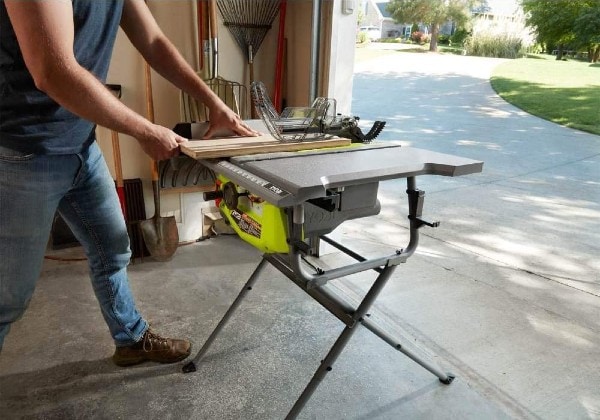
The size and portability are important for all kinds of woodworkers but for different reasons. A professional contractor will probably be more concerned with how easy it is to transport the table saw from job site to job site. In this instance, weight is not nearly as important as a capable cart stand.
For master woodworkers and weekend hobbyists alike, the size of a table saw will come down to the size of the workshop. Benchtop table saws are the smallest type with cabinet table saws being significantly larger. However, even hybrid table saws, fairly large in their own right, often have caster wheels for movement within a workshop.
8-1/4-Inch vs 10-Inch Table Saws
There are two main sizes: 10-inch and 8-1/4-inch table saws. The main difference between them is how deeply you cut in a single pass.
- A 10-inch table saw will, roughly speaking, allow you to cut with a maximum depth of around 3-1/2 inches at 90 degrees and 2-1/4 inches at 45 degrees.
- 8-1/4 inch table saw you will be limited to approximately 2-1/5 inches of maximum depth at 90 degrees and 1-3/4 inches at 45 degrees.
You can get around maximum cutting depth limitations with proper measurements and cutting the opposite face of the workpiece. However, this method takes more time, is prone to human error, and generally just does not produce as consistently good results.
Another thing to consider is getting a table saw with the same size blade as other saws in your arsenal. This can cut down on the number of blades needed as they can be switched from one saw to another. The blades of an 8-1/4 table saw can be used on an 8-1/4 or a 10-inch miter saw, for example.
Finally, note that 10-inch blades are generally more expensive than 8-1/4 quality-equivalent blades so this is yet another consideration if you have tight budget constraints.
Read more: Table Saw Blade Types Explained
Maximum Rip Capacity
The maximum rip capacity puts a ceiling on the size of your projects but should otherwise not be the defining quality. If the table saw is needed for light commercial work, make sure to get a cabinet table saw with an extension that allows for rip cuts of at least 32”.
Moving further down the line in terms of importance, the minimum rip capacity can occasionally be important– especially for experienced woodworkers. Finally, some table saws allow for a decent maximum rip cut to the left of the blade which is useful for left-handed users or those who do not want to have to invert measurements.
Rip Fence Quality
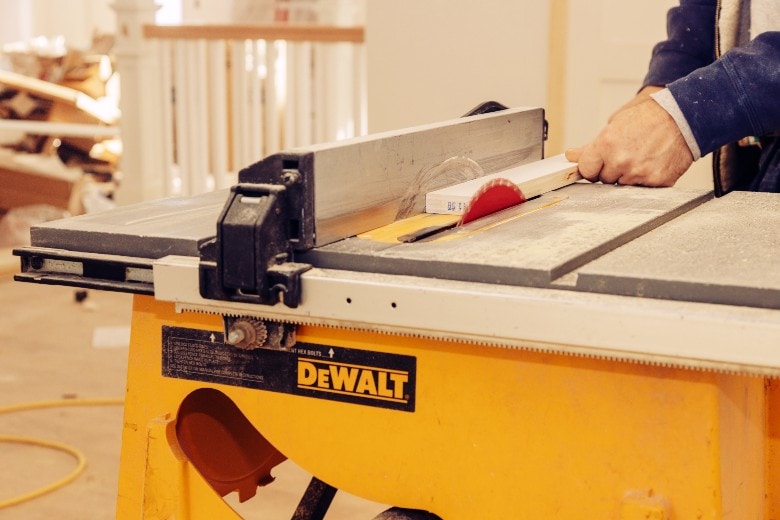
This is definitely one of the more important factors when using a table saw, but it may not measure up quite as much when purchasing one. When choosing a table saw, it is important to consider how stable the fence locks and how fine of adjustments it can make.
The two main methods of locking a fence are bolting the fence directly onto the table, usually on a rack and pinion, or with a cam lock. While the cam lock is generally the easier and more convenient of the two, you need to make sure that it locks on tight. Biesemeyer is considered the pinnacle with cam lock fences, but many others can be flimsy.
The materials are somewhat important as aluminum and certain types of plastic allow the workpiece to slide along the fence easier. Also consider how easy it is to read the measurements, whether on the table or the fence.
Read More: Must-Have Table Saw Accessories
Safety Features
Given how dangerous a table saw is, table saw safely is a paramount concern. That said, all of today’s table saws come with a wide range of safety features. The blade guard is the most obvious with most consideration of this feature falling on how easy it is to remove when you need to change or adjust the blade.
After that, the big factor comes down to a splitter or a riving knife, with the riving knife being superior since it moves up and down together with the blade. Anti-kickback pawls that can hook into the workpiece and prevent kickback are also common and important. Finally, some table saws like the SawStop have blade brakes that stop the blade almost instantaneously if it comes into contact with skin.
One thing to consider when purchasing a pre-owned table saw is that models made before 2008 had different safety standards than they do today so beware of that when buying a used table saw.
Read more: How To Safely Use A Table Saw
How Good Is The Dust Collection System
This is more of a convenience factor for most people, though professionals or those with allergies may rate it more important. The main issue is that poor dust collection allows sawdust to build up on the workpiece. This in turn reduces the blade’s cutting effectiveness and can dull the blade quicker than normal.
Most table saws allow for the hook-up of a vac system, though those with multiple connections perform the best. The size of the dust vac port is a major factor, though its effectiveness will heavily depend on the quality of the vacuum. A dual dust collection system with a vac port on the blade guard is currently the best option.
Dado Blade Compatibility
If you intend to cut a lot of dadoes and grooves, having the ability to add a dado blade becomes a necessity and should not be overlooked when shopping for a table.
Most of today’s table saws accept at least one type of dado blade, though the size of the dado cut varies significantly. The stacked dado blade uses two blades with several chippers spaced in between. In this instance, the table saw will need a longer arbor to handle the additional blades and spacers.
The wobble dado blade allows for finer adjustments but cuts rougher with a greater chance of tearout. That said, either type of dado blade will require additional length with the arbor. Just make sure not to forego the washer or arbor flange as this can be dangerous, but needs to be factored into the arbor length as well.
Motor types
This is one of the more obscure qualities of table saws, and it often takes an experienced user to understand the impacts of each. Generally, the choice between a direct drive and belt-driven motor, with all other factors being equal, comes down to cutting power vs cutting precision.
A direct-drive motor connects directly to the arbor and spins with the maximum power output, but also introduces far more vibration into the cut. As such, whatever time might be saved from more power will have to be spent on making sure that the cut remains true when feeding the workpiece into the blade.
A belt-driven motor, on the other hand, produces less vibration– do not let anyone tell you otherwise. The only reason some say belt drives produce more vibration is that they tend to use significantly more powerful motors. But when comparing equivalent motors, belt drives generate far less vibration.
Read More: Table Saw Basics Explained
Where Can You Buy A Table Saw?
Depending on the type and quality of table saw, as well as the potential return policy, there are plenty of places to buy one. For those who prefer to see what they pay for ahead of time, department stores like Lowes, Home Depot, and Harbor Freight always have a wide range of different models to choose from.
On top of that, buying a table saw at a brick-and-mortar store also has the advantage of allowing for a significantly easier return should the need arise. Whatever you can find at a brick-and-mortar store, you can usually find on Amazon as well. While Amazon is a great place to find good deals, the return process can be a bit expensive as you often have to pay for shipping.
For anyone who does not mind buying used, Craigslist, Facebook Marketplace, and occasionally Ebay are all decent options. Of course, purchasing a used table saw generally comes with either a no-return policy or an extremely return small window. As such, Craigslist and Facebook Marketplace might be better options to get a look at the tool before paying for it.
Best Time To Buy A Table Saw
Table saws are expensive. Obviously, the best time to buy is when table saws are on sale. Table saw makers will usually offer great discounts around holidays. One of the best times to buy a table saw is during Black Friday and Cyber Monday sales periods. Check out this article for the best Black Friday Table Saw deals.
Summary
Now that you’ve read this table saw buying guide It should be pretty easy to find the right table saw for you. Remember, the most important thing when choosing a table saw is understanding what it will be used for and what specs are necessary to finish those projects.
Outside of occasional DIYers, it often pays more in the long run to spend a bit more upfront and get a table saw that will last for years. Either way, there should be no issues comparing all of the models now.
